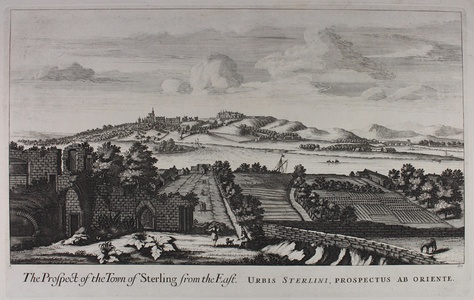| Method | Copper engraving |
| Artist | John Slezer |
| Published | c.1693 |
| Dimensions | Image 235 x 420 mm, Plate 270 x 430 mm, Sheet 335 x 565 mm |
| Notes |
A fine large-scale, seventeenth century engraving of Sterling, now known as Stirling, as seen from the ruins of Cambuskenneth Abbey in the East. On the top of the hill is Stirling Castle, to the left is the town and the Church of the Holy Rude. On the River Forth we see rowing boats and boats with masts. On the right, in the background, is Stirling Old Bridge and in the central foreground are two men and a dog. John Slezer (c.1650 - 1717) was a German military engineer and artist. In 1669 he was appointed Surveyor of his Majesties Stores and Magazines, which involved compiling detailed surveys of the country's fortifications. He is best known for his Theatrum Scotiae, a series of engravings of views of castles, abbeys, towns, and seats of the nobility he encountered whilst travelling throughout Scotland in his capacity as Captain of the Artillery Company. He was imprisoned in 1688 as a supporter of King James VII, following the latter's deposition in favour of William III and Mary II, but was released the following year. He published the first volume of Theatrum Scotiae in 1693, but sales were poor and he applied to the Government for a grant to proceed with a continuation of the work that was to be called Scotia Ilustrata. This never materialised, however, and increasing financial difficulties forced Slezer to spend the last years of his life in the Holyrood Abbey sanctuary to avoid debtors' prison. Condition: Soft crease to centre. Some time toning to sheet. |
| Framing | unmounted |
| Price | £200.00 |
| Stock ID | 47824 |

